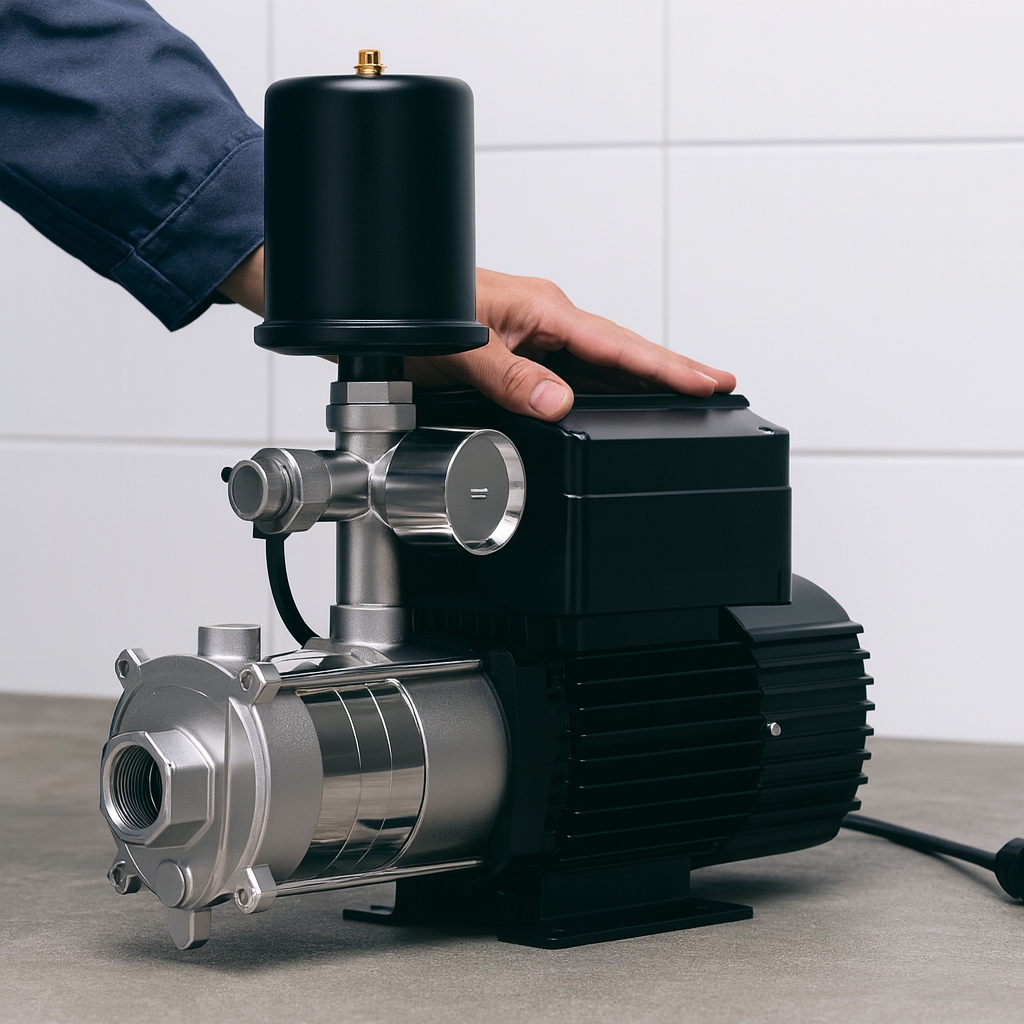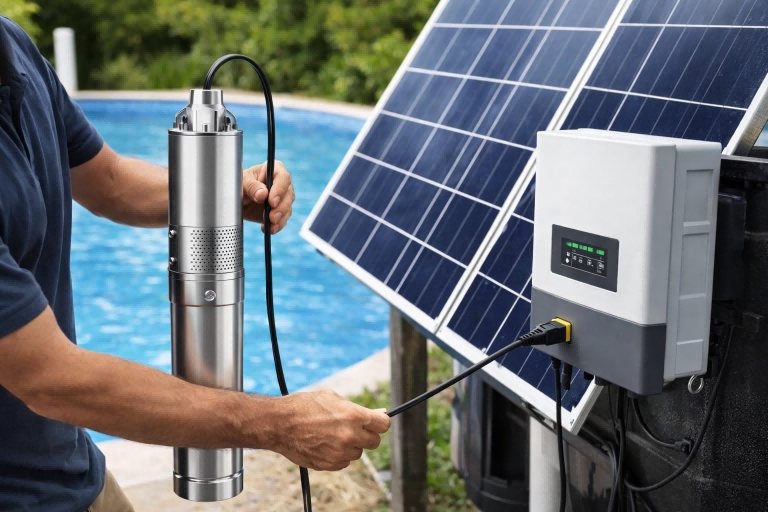Struggling with inefficient fluid transfer?
This leads to high energy bills and poor performance.
The right centrifugal pump can solve these problems effectively and affordably for your business.
A centrifugal pump is best for transferring large volumes of low-viscosity fluids, like water, at low to medium pressures.
They are the top choice for residential water supply, agricultural irrigation, and many industrial processes due to their simple design, efficiency, and cost-effectiveness for high-flow applications.

Choosing the right pump is crucial for any system's success.
It can be the difference between a smooth, efficient operation and a constant source of problems and expenses.
Selecting a pump isn't just about moving liquid; it's about optimizing your entire process for reliability and cost-effectiveness.
To make the best decision for your clients or your own operations, it's essential to understand the specific scenarios where a centrifugal pump truly shines.
Let's explore the key applications and operational principles that make this pump type a cornerstone of fluid dynamics.
Understanding the Basic Principle of a Centrifugal Pump
Are you unsure how a centrifugal pump actually works?
This lack of clarity can make it hard to troubleshoot or select the right one.
Understanding its simple mechanism reveals why it's so reliable.
A centrifugal pump uses a rotating impeller to create an outward force on a liquid.
This action converts rotational energy into kinetic energy, accelerating the fluid.
The volute casing then slows the fluid down, converting this kinetic energy into pressure, which pushes the liquid out.
To truly grasp when to use a centrifugal pump, we must first look inside.
The magic happens through a combination of simple mechanics and fluid dynamics.
This pump is not a complex piece of machinery at its core.
Its elegance lies in its simplicity and efficiency.
Understanding this principle is the first step toward confident selection and application for your business needs, ensuring you provide the best solution for your customers.
Let's break down the key components and how they work together.
The Impeller: The Heart of the Pump
The impeller is the most critical component.
It is a rotor with a series of backward-curved vanes.
When the pump shaft spins, the impeller spins with it.
Fluid enters the pump at the center of the impeller, known as the eye.
The spinning vanes catch this fluid and accelerate it radially outward.
This rapid acceleration is what imparts kinetic energy to the liquid.
There are different types of impellers designed for various jobs.
- Open Impellers: These are best for fluids with some solids, as they are less likely to clog.
- Semi-Open Impellers: They offer a balance between efficiency and solids-handling capability.
- Closed Impellers: These are the most efficient type but are only suitable for clean, clear liquids.
Choosing the correct impeller type is vital for the pump's performance and longevity in a specific application.
The Volute Casing: Converting Speed to Pressure
Once the fluid leaves the impeller at high velocity, it enters the volute.
The volute is a specially shaped casing that gradually widens.
Think of it as a funnel expanding outward from the impeller.
This increase in area forces the high-speed liquid to slow down.
According to Bernoulli's principle, as the fluid's velocity decreases, its pressure must increase.
This conversion process is the key to the pump's function.
The volute efficiently transforms the kinetic energy from the impeller into useful pressure.
This pressure is what drives the fluid through the pipes and to its destination.
| Component | Primary Function | Impact on Performance |
|---|---|---|
| Impeller | Accelerates fluid, creating kinetic energy. | Determines the flow rate and head (pressure) potential. |
| Volute | Converts kinetic energy into pressure energy. | Greatly influences the pump's overall efficiency. |
| Shaft | Transmits rotational power from the motor. | Its strength and alignment affect reliability. |
| Seals | Prevent leakage between the shaft and casing. | Critical for safety, efficiency, and preventing damage. |
High-Flow, Low-Pressure Applications
Do you need to move a lot of water quickly without high pressure?
Using the wrong pump can waste energy and money.
Centrifugal pumps are perfectly designed for high-volume, low-head tasks.
Centrifugal pumps excel in applications requiring high flow rates at low to moderate pressures.
This makes them ideal for general water circulation, drainage systems, and large-scale irrigation, where moving volume is more important than overcoming significant resistance or elevation.
The fundamental design of a centrifugal pump makes it a champion of volume.
Its ability to continuously pull in and sling fluid outward allows it to move substantial quantities of liquid with remarkable efficiency.
This is why they are ubiquitous in so many industries.
However, this strength in flow comes with a trade-off in pressure.
While they can generate adequate pressure for many jobs, they are not typically the first choice for high-pressure systems.
Let’s examine the specific applications where this high-flow characteristic is a major advantage.
Municipal Water Supply and Distribution
Municipal water systems are a prime example.
Water must be moved from treatment plants to reservoirs and then distributed throughout a city.
This requires moving millions of gallons per day.
Large centrifugal pumps are used in booster stations to maintain adequate flow throughout the network.
Their role is not to create extreme pressure but to ensure a steady, reliable volume reaches every home and business.
The focus is on consistent bulk transfer of water over large areas.
Agricultural Irrigation
Farming relies heavily on moving water from a source to the fields.
Whether pulling from a river, a well, or a canal, the primary goal is volume.
A farmer needs to deliver enough water to cover many acres of land.
Centrifugal pumps are the workhorses of irrigation.
They can efficiently supply the high flow rates needed for large sprinkler systems or flood irrigation.
For an agricultural distributor like Andrew's business in Australia, providing reliable and efficient irrigation pumps is a core part of the business model.
General Industrial Transfer
Many industrial plants need to move liquids around their facilities.
This can include:
- Transferring raw materials from storage tanks.
- Circulating cooling water through heat exchangers.
- Moving wastewater to treatment areas.
In most of these cases, the requirement is for consistent, high-volume transfer at relatively low pressures.
Centrifugal pumps are simple, reliable, and cost-effective for these duties.
Their straightforward design makes them easy to maintain, which is a major benefit in a busy industrial environment.
| Application | Key Requirement | Why Centrifugal Pumps Are Ideal |
|---|---|---|
| Cooling Towers | High Volume | Efficiently circulates large amounts of water. |
| Dewatering | Fast Removal | Quickly moves water from construction sites or mines. |
| Flood Control | Massive Flow | Can pump huge volumes of water away from an area. |
Handling Low-Viscosity Fluids
Is your fluid thick and sticky?
A centrifugal pump will struggle and fail.
These pumps are designed specifically for thin, easy-to-flow liquids like water.
Centrifugal pumps are the optimal choice for moving low-viscosity fluids (thin liquids).
Their operating principle relies on accelerating the fluid, which is highly inefficient with thick liquids that resist flow.
They work best with water, light oils, solvents, and similar substances.
A pump's performance is directly tied to the properties of the fluid it is moving.
Viscosity, which is a measure of a fluid's resistance to flow, is a critical factor for centrifugal pumps.
Think of the difference between pouring water and pouring honey.
The impeller in a centrifugal pump is designed to sling water outward with ease.
When it encounters a thick fluid like honey, it can't generate the same velocity.
This leads to a dramatic drop in performance and a sharp increase in power consumption.
Understanding this limitation is key to avoiding costly mistakes in pump selection.
Why Viscosity Matters
Viscosity creates internal friction within a fluid.
A centrifugal pump's impeller must overcome this friction to get the fluid moving.
With low-viscosity fluids like water (viscosity of 1 centipoise, or cP), this is easy.
The impeller requires minimal extra energy to accelerate the fluid.
As viscosity increases, the internal friction skyrockets.
The pump has to work much harder just to shear the fluid and move it.
- Decreased Flow: The pump will move significantly less volume.
- Reduced Head: The pressure it can generate will drop sharply.
- Increased Power Draw: The motor will consume much more electricity, potentially leading to overload.
The Viscosity Threshold
There is a practical limit to what a centrifugal pump can handle.
While there is no single magic number, performance begins to degrade noticeably as viscosity rises.
| Viscosity (cP) | Fluid Example | Performance Impact on Centrifugal Pump |
|---|---|---|
| 1 | Water | Optimal Performance |
| 10-100 | Light Oils, Glycol | Minor corrections needed for pump selection. |
| 100-500 | SAE 10 Oil, Syrups | Significant performance drop. Requires analysis. |
| >500 | Molasses, Heavy Oil | Generally unsuitable. Requires a positive displacement pump. |
For fluids thicker than a light oil, you must seriously consider an alternative.
Positive displacement pumps, such as gear or lobe pumps, are designed to handle high-viscosity liquids.
They trap a fixed amount of fluid and force it out, regardless of thickness.
For a business owner like Andrew, understanding this distinction is crucial for advising customers correctly and protecting his reputation for providing quality, effective solutions.
Cost-Effectiveness and Simple Maintenance
Worried about high initial costs and complex repairs?
This can eat into your profits and cause downtime.
Centrifugal pumps offer an economical and easy-to-maintain solution for many applications.
Due to their simple design with few moving parts, centrifugal pumps have a lower initial purchase price and are cheaper to maintain than other pump types.
This reliability and low total cost of ownership make them a highly economical choice for continuous, high-volume operations.
For any business, the total cost of ownership is a critical metric.
This includes the initial purchase price, installation costs, energy consumption, and maintenance expenses over the pump's lifetime.
In many common scenarios, centrifugal pumps win on nearly all fronts.
Their widespread use has led to mass production, driving down manufacturing costs.
More importantly, their simple and robust design minimizes what can go wrong, making them a favorite for operators who value reliability and uptime.
Lower Initial Investment
Compared to more complex pump technologies, centrifugal pumps are generally less expensive to buy.
The design is straightforward: an impeller, a volute, a shaft, and seals.
There are no tight tolerances or complex reciprocating parts.
This simplicity translates directly into lower manufacturing costs.
For a distributor, this means the ability to offer competitively priced products to customers like Andrew, who value both quality and a good price point.
A business can equip an entire facility with centrifugal pumps for a fraction of the cost of outfitting it with positive displacement pumps for the same flow rate.
Simplified Maintenance and Repairs
Maintenance is where centrifugal pumps truly shine.
The primary wear components are the seals and bearings.
These are typically standard parts that are easy to access and replace.
- Routine Checks: Maintenance often involves simple visual inspections, checking for leaks, and listening for unusual noises from the bearings.
- Fewer Moving Parts: With only one primary moving part (the impeller assembly), there are far fewer things to break compared to a piston or diaphragm pump.
- Accessibility: Most designs allow for easy access to the impeller and seals without having to disconnect the entire pump from the piping.
This ease of maintenance reduces downtime and lowers labor costs.
An in-house technician can often perform most repairs, avoiding the need for expensive specialist service calls.
Long-Term Reliability
The simple, robust design contributes to a long operational life.
When operated within their designed parameters (the best efficiency point), centrifugal pumps can run for years with only minimal intervention.
This reliability is a massive asset in industries where downtime is extremely costly, such as in chemical processing or power generation.
The key is proper initial selection.
Choosing a pump that is correctly sized for the application ensures it operates efficiently and without excessive wear, maximizing its lifespan and delivering the best return on investment.
When a Centrifugal Pump is NOT the Right Choice
Think a centrifugal pump is a one-size-fits-all solution?
Using it in the wrong application leads to poor performance and premature failure.
Knowing its limitations is as crucial as knowing its strengths.
Do not use a centrifugal pump for high-pressure, low-flow applications, for handling very thick or viscous fluids, or when precise dosing is required.
Positive displacement pumps are the correct choice for these specific scenarios, as they are designed to overcome these challenges.
A powerful tool used for the wrong job is not only ineffective but can also be damaging.
The same is true for pumps.
A centrifugal pump is an excellent generalist for high-flow applications, but it has clear weaknesses.
Forcing it into a role it wasn't designed for will result in inefficiency, high energy consumption, and frequent breakdowns.
A savvy business owner like Andrew understands that providing the right pump for the job, even if it's not a centrifugal one, builds trust and ensures customer success.
Let's clearly define the situations where you should look for an alternative.
High-Pressure, Low-Flow Requirements
Centrifugal pumps generate pressure by converting velocity.
To create very high pressures, the impeller would need to spin at incredibly high speeds or be very large.
This becomes inefficient and impractical beyond a certain point.
While multistage centrifugal pumps can achieve higher pressures, there is a limit.
- Positive Displacement Pumps: Piston pumps, plunger pumps, and diaphragm pumps excel here. They trap a fixed volume of fluid and force it out, generating very high pressures regardless of the flow rate.
- Typical Applications: High-pressure cleaning, reverse osmosis systems, and hydraulic systems.
Handling High-Viscosity Fluids
As we discussed earlier, viscosity is the enemy of centrifugal pumps.
The impeller churns and shears thick fluids instead of efficiently moving them.
This wastes enormous amounts of energy and can cause the pump to overheat.
- Positive Displacement Pumps: Gear pumps, lobe pumps, and screw pumps are ideal. They move fluid in distinct pockets, and their performance is much less affected by viscosity.
- Typical Applications: Pumping molasses, heavy oils, resins, and food products like tomato paste.
Need for Precise Metering or Dosing
The output of a centrifugal pump varies with the system's backpressure.
If a valve is partially closed downstream, the flow rate from the pump will decrease.
This makes them unsuitable for applications where a precise, constant volume of liquid must be delivered.
- Metering Pumps: Diaphragm and peristaltic pumps are designed for this. They deliver a highly accurate and repeatable volume with each stroke or rotation, unaffected by pressure changes.
- Typical Applications: Chemical injection in water treatment, adding ingredients in food processing, and pharmaceutical manufacturing.
Presence of Abrasive Solids or Gases
Standard centrifugal pumps are not built to handle hard, abrasive solids.
These particles can quickly erode the impeller and volute, destroying the pump.
They are also not self-priming and cannot handle large amounts of entrained gas or vapor.
| Problematic Condition | Why It's Bad for Centrifugal Pumps | Better Pump Type |
|---|---|---|
| Abrasive Solids | Causes rapid erosion of the impeller and casing. | Slurry Pump (a specialized centrifugal) or Peristaltic Pump |
| Entrained Gas | Can cause the pump to lose prime and stop pumping (vapor lock). | Self-Priming Centrifugal Pump or Screw Pump |
| Dry Running | Lack of fluid for lubrication and cooling destroys seals and bearings. | Peristaltic Pump or Air-Operated Diaphragm Pump |
The Role of Variable Speed Drives (VSDs)
Is your pump always running at full speed?
This wastes a massive amount of energy when demand is low.
Adding a Variable Speed Drive (VSD) allows your pump to intelligently match its output to the need.
A Variable Speed Drive, or VFD, controls a centrifugal pump's motor speed.
This allows the pump's flow and pressure to be adjusted precisely to match system demand, drastically reducing energy consumption by up to 50% or more and extending the pump's lifespan.
A traditional centrifugal pump system is like a car with only one speed: full throttle.
It's either on or off.
To control flow, you typically use a throttling valve, which is like driving with the accelerator floored and using the brake to control your speed.
It's incredibly wasteful.
A Variable Speed Drive (VSD), also known as a Variable Frequency Drive (VFD), changes this paradigm completely.
It introduces intelligence into the system, creating a "smart" pump.
For a modern pump supplier, offering VSD-integrated solutions is essential for meeting customer demands for efficiency and performance.
How a VSD Works with a Pump
A VSD controls the electrical frequency supplied to the pump's motor.
By changing the frequency, it changes the motor's rotational speed (RPM).
The relationship between speed, flow, and power in a centrifugal pump is governed by the Pump Affinity Laws.
- Flow is directly proportional to speed. (50% speed ≈ 50% flow)
- Pressure (Head) is proportional to the square of the speed. (50% speed ≈ 25% pressure)
- Power is proportional to the cube of the speed. (50% speed ≈ 12.5% power)
This last point is the most important.
A small reduction in speed leads to a massive reduction in power consumption.
Reducing the pump speed by just 20% can reduce energy use by nearly 50%.
Key Benefits of Using a VSD
The advantages of pairing a VSD with a centrifugal pump are significant, especially in systems with fluctuating demand.
Massive Energy Savings
This is the number one reason to use a VSD.
In applications like HVAC systems or residential water boosters, demand is rarely at 100%.
By slowing the pump down to match the actual need, VSDs eliminate wasted energy from throttling and constant full-speed operation.
The return on investment can often be less than two years.
Constant Pressure Control
In a booster pump system for a building, a VSD can maintain perfectly constant water pressure.
A pressure sensor provides feedback to the VSD.
If someone opens a tap and pressure starts to drop, the VSD instantly speeds up the pump to compensate.
When the tap is closed, it slows down.
This eliminates the pressure fluctuations common in older systems and provides a much better user experience.
This is a key feature of the intelligent booster pumps that businesses like RAFSUN provide.
Increased Equipment Lifespan
Running a pump at full speed 100% of the time causes maximum wear and tear.
Soft-starting the motor with a VSD reduces electrical and mechanical stress.
Operating at lower average speeds reduces wear on bearings, seals, and the impeller.
It also mitigates issues like "water hammer" (pressure surges) by gently ramping up and down.
This leads to a longer lifespan for the entire pumping system and fewer maintenance-related breakdowns.
| Feature | Without VSD | With VSD |
|---|---|---|
| Speed Control | Fixed, 100% speed | Variable, 0-100% speed based on demand |
| Energy Consumption | High, especially at partial load | Low, optimized for the exact demand (power ~ speed³) |
| Pressure Control | Fluctuates, requires pressure-reducing valves | Stable, constant pressure maintained automatically |
| Mechanical Stress | High (hard starts, constant high speed) | Low (soft starts, lower average speed) |
Conclusion
A centrifugal pump is the ideal choice for high-flow, low-pressure applications involving thin liquids.
Its simple, robust design makes it a cost-effective and reliable workhorse for many industries.
FAQs
What is the main purpose of a centrifugal pump?
Its main purpose is to efficiently transport large volumes of low-viscosity fluids, like water, by converting rotational energy from a motor into fluid motion.
What is the difference between a centrifugal pump and a rotary pump?
A centrifugal pump uses an impeller to generate flow via velocity.
A rotary pump is a positive displacement type that traps and moves fluid using gears or lobes.
Can a centrifugal pump run without water?
No, running a centrifugal pump without water (running dry) will quickly destroy the mechanical seals and bearings due to lack of lubrication and cooling, causing catastrophic failure.
How do you increase the pressure of a centrifugal pump?
You can increase pressure by increasing the impeller's rotational speed (using a VFD), using a larger diameter impeller, or using a multistage pump with multiple impellers in series.
What are the two main parts of a centrifugal pump?
The two main parts are the rotating impeller, which imparts velocity to the fluid, and the stationary volute casing, which converts that velocity into pressure.
What is the disadvantage of a centrifugal pump?
Its main disadvantages are its inability to handle high-viscosity fluids, its poor performance in high-pressure/low-flow scenarios, and its susceptibility to damage if it runs dry.
Why is a centrifugal pump not a positive displacement pump?
Its output flow rate varies significantly with system pressure, whereas a positive displacement pump delivers a nearly constant flow regardless of the pressure it is working against.








